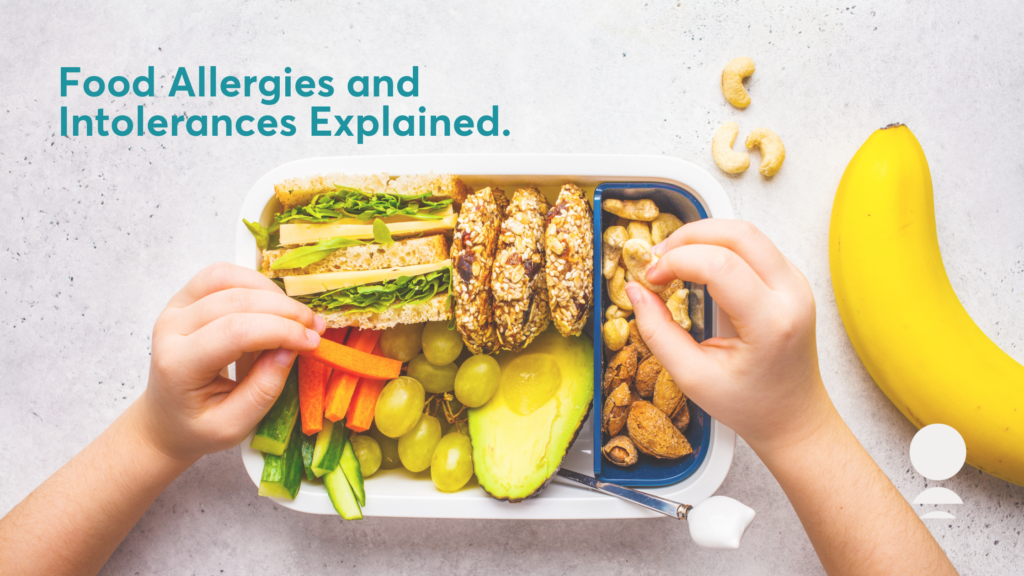FOOD ALLERGY 101- EVERYTHING YOU NEED TO KNOW
While food allergies are more serious than food intolerances, to varying degrees they can both impact your health, wellbeing and lifestyle. And if you think that food allergies and intolerances are on the rise, you would be absolutely right. Across the entire Western world, there has been an alarming rise in the rates of both food allergies and intolerances – especially over the past 30 years. In fact, Australia now holds the dubious crown as the global capital of food allergies, closely followed by the UK. ***
Food Allergies and Food Intolerances on the Rise
Food allergies are now seen in 10 per cent of infants, 4-8 per cent of children and approximately 2 per cent of Australian adults. While many young children outgrow their food allergies, allergies that develop in adults typically persist. Hospital admissions for anaphylaxis in Australia have doubled in the past decade, with the increase for children aged up to four-years-old even higher – with a five-fold increase in the last 10 years. ***
Recent studies show that higher levels of food allergies are more prevalent in urban areas compared to rural environments. One study in Melbourne found that children with vitamin D deficiency were 11 times more likely to develop a peanut allergy. Conversely, children with older siblings and pets are less likely to develop allergies, possibly due to greater exposure to microbes. ***
Allergies and Intolerances and the Role of the Gut
The gut microbiome has been altered by the recent changes in food manufacturing, food production and high sugar diets over the past 50 years. Previous advice to avoid allergens during the weaning phase to solids is now outdated, with significant research showing that exposure to known allergenic foods is a protective factor.
It is now recommended that all children, regardless of their family history of allergies, be exposed to allergenic foods during the first 12 months of life. The gut’s immune system then recognises these foods as belonging to normal food groups and therefore less likely to develop an allergic response. ***
What is the Difference Between Food Allergies and Food Intolerance?
Food intolerances are often confused with food allergies. An important medical difference is that while both occur as a result of the immune system reacting to a perceived ‘harmful’ food, an intolerance typically effects only the digestive system whereas an allergy can affect the entire body. Importantly, food allergies can trigger anaphylaxis, a potentially life-threatening response, however intolerances (except for sulphite and benzoate reactions) do not. *
The Differences in Simple Terms
· Food allergies can affect the entire body (lungs and airways, skin, gut etc) and are often lifelong
· Food intolerances are typically localised to the digestive tract and can be resolved
Speaking with Gabrielle Coulthurst, First Light Healthcare’s Accredited Practising Dietitian (APD, BNutDiet), foodallergies are typically more serious than an intolerance and can even be life threatening if untreated. “The reaction of a food allergy is usually immediate and even a small amount of the allergen can trigger a severe immune response. The allergen must be avoided as much as possible – even small contaminants can cause a severe response and can even long-term health issues if unmanaged, such as an increased risk of chronic diseases.”
“The symptoms of a food allergy can affect many parts of the body ranging from the gut to the respiratory system, even brain function, joint pain or skin reactions”
Food intolerances are typically less serious (not life threatening) compared to allergies, explains Gabrielle. “Food intolerances are typically delayed in their onset – taking anywhere from four minutes to four days to see a reaction, and they are often ‘dose-dependent’. This means that a small amount of the trigger food can be tolerated with no symptoms, but larger amounts will then trigger an immune response.”
“Each individual has a different threshold as to how much of the trigger food/s their immune system will tolerate and often intolerances will only affect the gut. Whilst allergies are usually developed from birth, intolerances can come and go and they can be developed over years due to a variety of factors that impact the immune system, such as the gut barrier and gut microbiome, and/or the liver.”
Gabrielle cites other contributing factors that may develop food intolerances including a history of IBS (Irritable Bowel Syndrome) and IBD (Irritable Bowel Disease) as well as gut issues, frequent antibiotic use, chronic mental or physical stress, autoimmune conditions, viruses and parasite infections.
“Then there is the term ‘food sensitivity,’” explains Gabrielle. “This term is used more in alternative medicine spaces, refering to a milder inflammatory reaction that is often delayed.”
What are the Most Common Food Allergies?
According to Gabrielle the most common allergens in foods are gluten, dairy, peanuts, chocolate, legumes, eggs, tree nuts, shellfish and fish, caffeine, soy, yeast, corn, citrus, beef, MSG and food additives and salicylates.
What are the Most Common Symptoms of Food Allergies and Intolerances?
Typical Food Allergy Symptoms
Food allergies symptoms can range from skin rashes and anaphylaxis, to diarrhoea, weight gain, migraines, muscle pain and fatigue. Additionally, according to Gabrielle if these allergies are not identified and treated, “They can worsen other pre-existing health issues such as IBS, joint pain, chronic fatigue and even your blood sugar levels.”
Symptoms can vary from person to person depending on how strongly the immune system reacts to the allergen. The most common symptoms of a food allergy reaction are:
· Anaphylaxis
· Swelling lips
· Coughing and wheezing and shortness of breath
· Dizziness or lightheaded
· Feeling sick and nauseous
· Stomach pain, diarrhoea, bloating and reflux
Other symptoms explains Gabrielle can include fatigue, weight gain, inflammation and pain, skin hives and rashes to joint pain, muscle pain, depression, brain fog, migraines, headaches, and unexplained nutrient deficiencies such as iron, b12 and zinc.
Typical Food Intolerances Symptoms
These typical symptoms of food intolerances cites Gabrielle can include stomach pain, bloating, flatulence, diarrhoea, IBS, rashes, ulcers, and can also include hives, fatigue, or headaches. “While typically mild compared to food allergy symptoms, if food intolerances are not properly managed and treated, these symptoms can greatly affect your general health and wellbeing.”
How Do You Treat Someone with Food Allergies?
Treating Food AllergiesEven after a successful diagnosis of food allergies, avoiding trigger foods is challenging and accidental exposures are common. A regular review of the allergy action plan and how to use an EpiPen is required as the time delay between a diagnosis and the need to use an EpiPen can be months or even years apart. Further research is continuing on the complex factors in food allergies and will be an evolving area of healthcare. ***
The only successful method of managing a food allergy or intolerance is to avoid the foods containing that allergen or food component, and work on repairing the gut lining and gut microbiome and strengthening the immune system. **
If you suspect you or a loved one are having an allergic reaction to food and you don’t have easy access an EpiPen, Gabrielle suggests you go to the hospital as these reactions can be very serious and harmful. “If you suspect that a certain food is causing an allergic reaction, see your GP to discuss a referral for a food allergy test.”
“Although research is being conducted into medications and supplements that can prevent allergies, such as aiming for a Coeliac to eat gluten with no adverse health issues, currently, there is no treatment. This means that the allergic food must be avoided as much as possible.”
Treating Intolerances
Compared to food that must be avoided long term for those that have an allergic response, intolerances can often be treated and resolved by removing the trigger food/s and treating the underlying cause,” explains Gabrielle. “Rebalancing the immune system to reduce its hypersensitivity to the trigger food/s, repairing the gut lining and addressing gut bacteria and correcting nutrient deficiencies, as well as addressing other potential triggers such as stress management and liver toxicity.”
“The specific elimination diet therapy used to treat your intolerance/s depends on your symptom picture. The goal of this diet is to identify known food triggers and then eliminating them to rest the immune system and to reach a stage of significantly reduced symptoms, then slowly reintroducing foods by testing one at a time.”
According to Gabrielle, commonly well-researched food intolerance therapies include a low FODMAP diet, an Antihistamine diet, the RPAH elimination diet, or an individualised elimination diet. Intolerances can also be prevented, such as someone with a lactose intolerance taking the lactose enzyme (lactase) and choosing to assist digestion and therefore avoiding a reaction.
“These diets are often highly restrictive, so see a qualified nutrition expert such as a dietitian for tailored advice and support to help you implement your diet effectively and to help identify triggers and understand your symptom picture. It’s highly recommended you keep a food and symptom dairy and share it with your dietitian to help see patterns in intolerances and allergies.”
The Role of the Gut
Signs of an unhappy gut include constipation, diarrhoea, fatigue, reflux, bloating, gassiness and general gut pain. Sound familiar? Unfortunately, an unhealthy gut is extremely common, but there are strategies to improve your gut health.
Five Foods to add into your weekly routine to aid gut health, as suggested by nutritionist, Gabrielle Coulthurst:
1. Soaked chia seeds – a great start to the day, find great Breakfast Chia Pudding recipes online.
2. Brassica vegetables – including broccoli, broccoli sprouts, cauliflower, kale, brussel sprouts, cabbage. This group of vegetables is rich in a potent enzyme called sulforaphane which can have anti-inflammatory, cell-protecting, detoxifying, and gut-healing effects.
3. Berries – Hallelujah for berries. These little nutrient-packed powerhouse are WONDERFUL for gut health for many reasons. They are rich in fibre which helps to feed the good but bacteria
4. Oily fish, aim for 4 x servings of oily fish every week (preferably wild caught) – including tuna, salmon, sardines, mackerel, anchovies, and herring which are all rich sources of omega-3 anti-inflammatory and immune balancing fats
5. Walnuts, linseeds and chia seeds are both good sources of plant-based omega-3
Sources:
* Allergy Facts Australia
https://allergyfacts.org.au/allergy-anaphylaxis/food-allergy-or-intolerance
** Food Authority NSW
https://www.foodauthority.nsw.gov.au/consumer/life-events-and-food/allergy-and-intolerance
*** Medcast Australia
https://medcast.com.au/
FODMAP Diet
Fermentable Oligosaccharides, Disaccharides, Monosaccharides and Polyols
RPAH Elimination Diet
Royal Prince Albert Hospital Elimination Diet
By Tracey Hordern
Reviewed by Gabrielle Coulthurst




